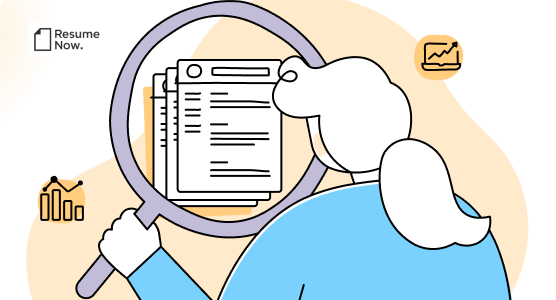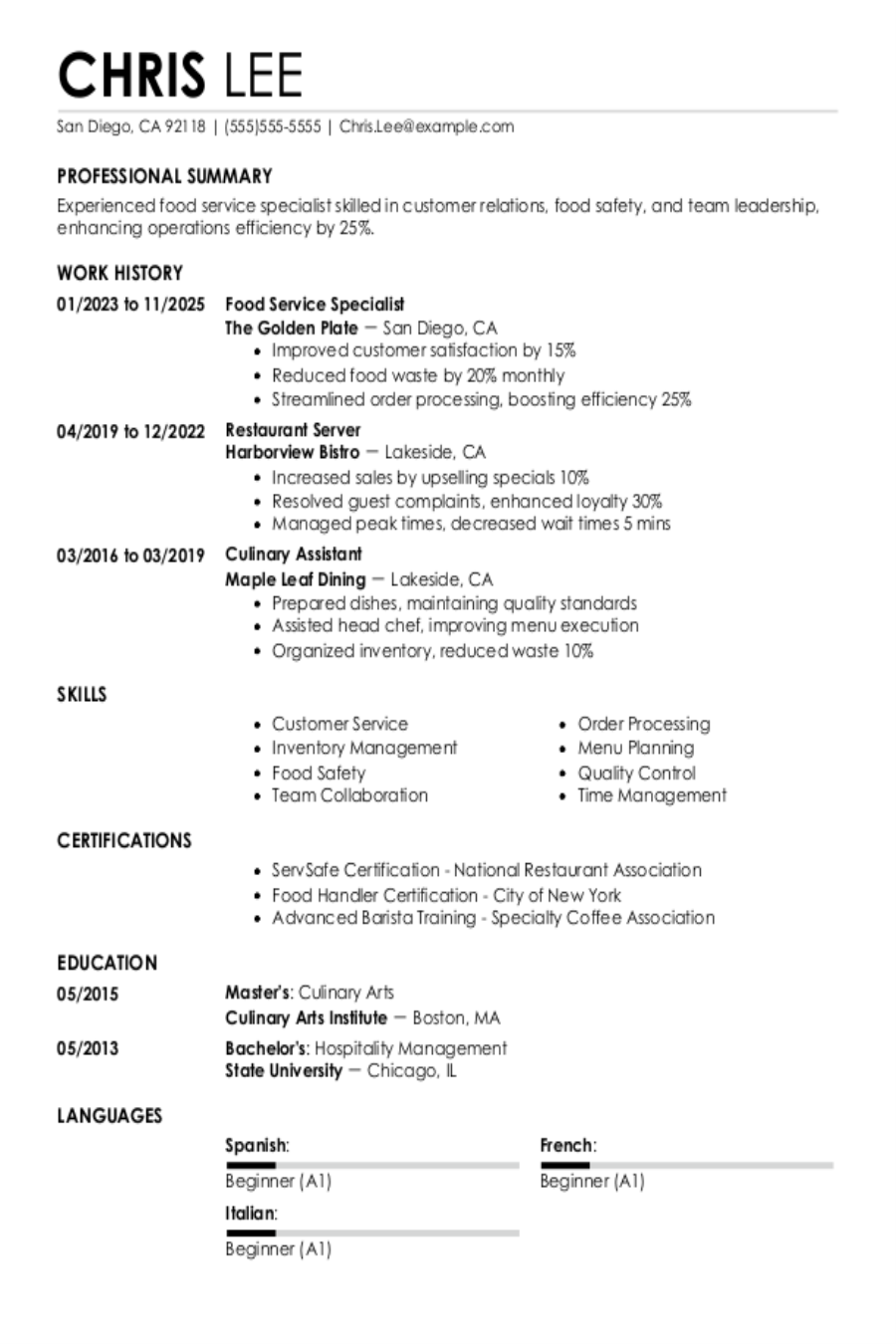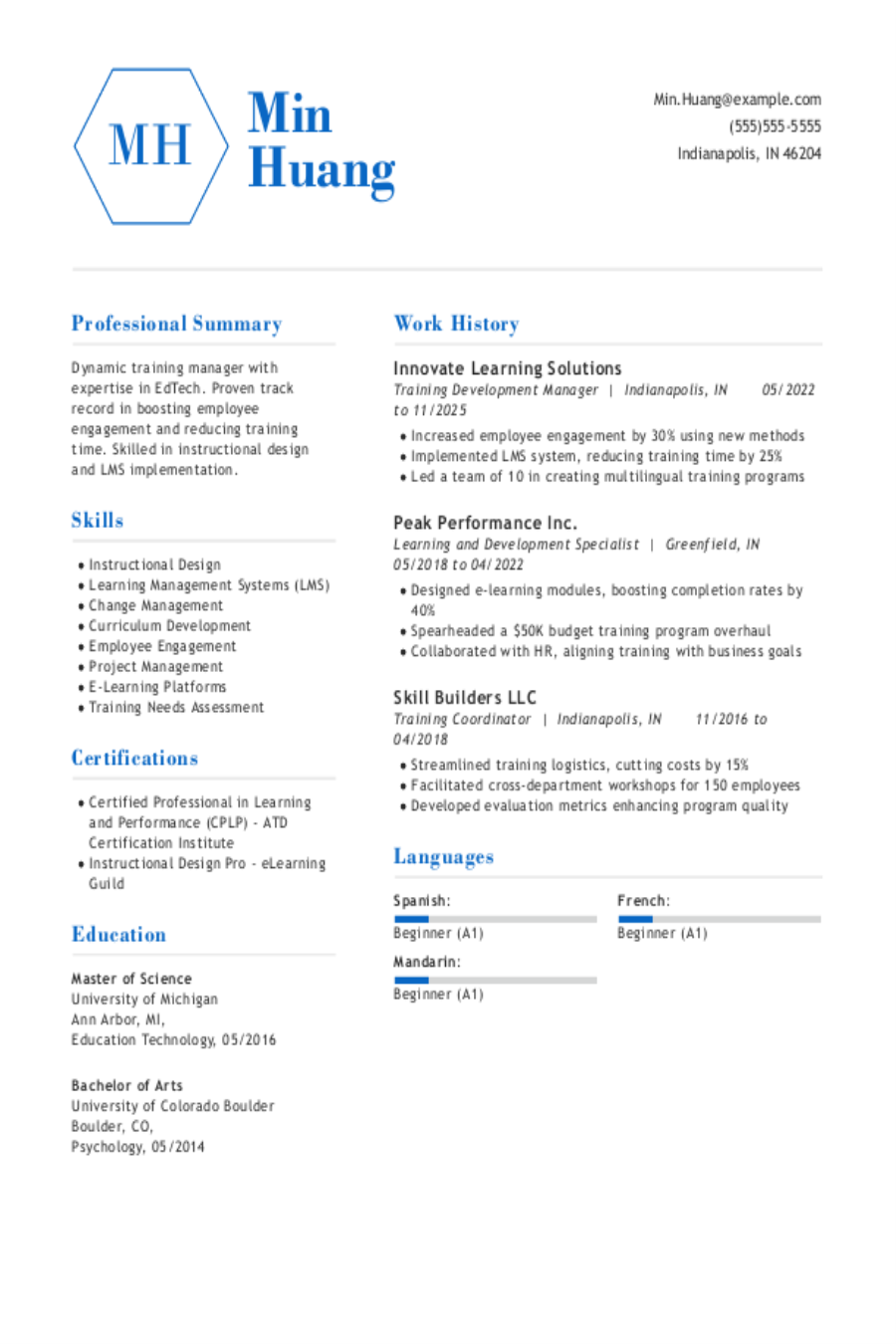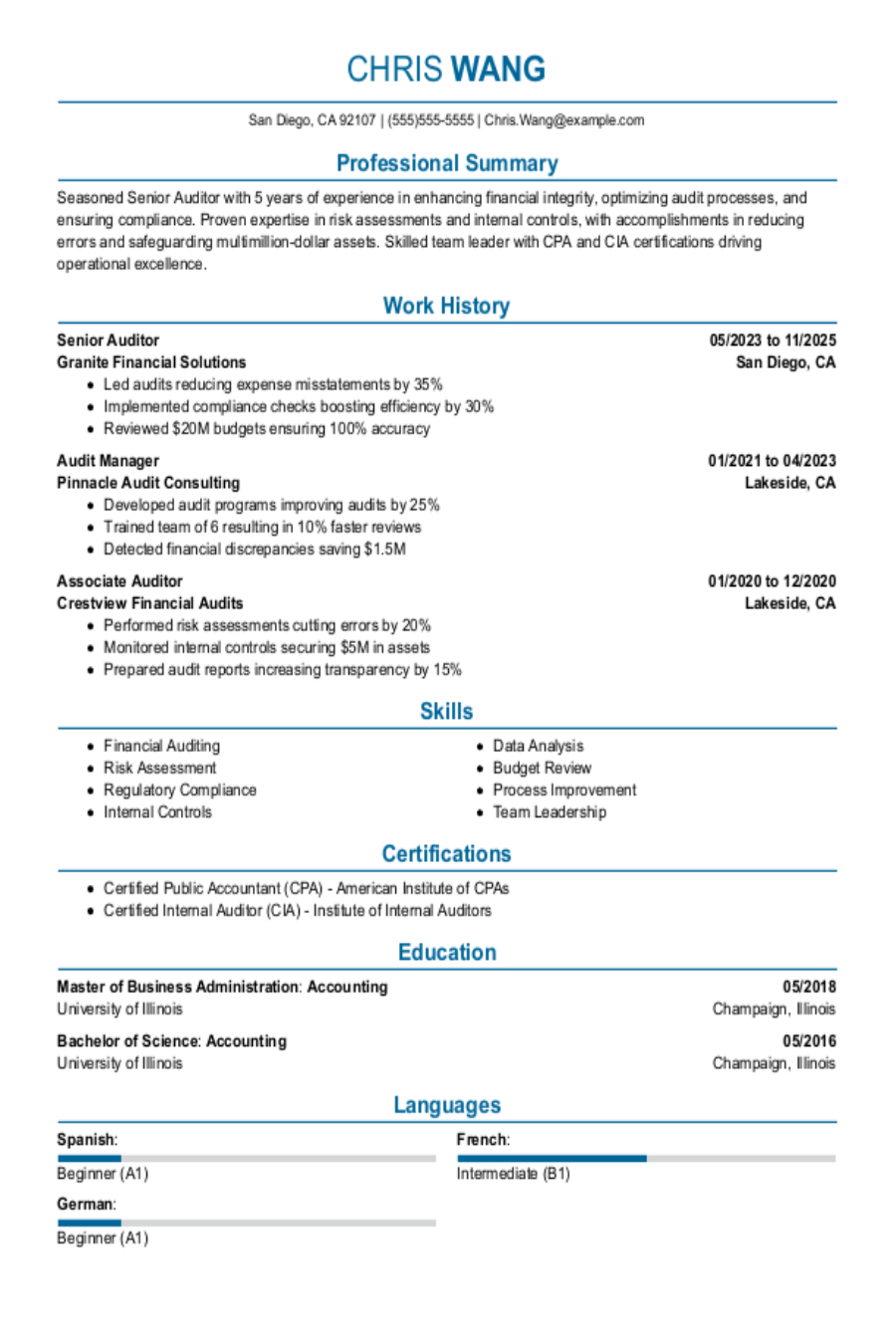In a job market where everyone has similar qualifications, how can you make yourself stand out in a sea of applicants?
Unique skills help distinguish your resume from competitors. Among them, language skills are some of the most sought-after.
By showing off your language proficiency, you immediately make yourself more appealing to a broader range of employers. We'll show you how to display them effectively on your resume.
Here's what we'll cover:
- Why language skills are important
- How to determine your language proficiency levels
- Different scales you can use for your language skills
- Adding language skills to your resume
- Other skills guides that might be helpful to you
Need an impressive resume to showcase your language skills? Try creating your resume with Resume Now's AI Resume Builder. Our tool helps you make your resume quickly with AI writing assistance, automatic formatting, and unique, ready-to-use templates.
What Are Resume Language Skills, and Why Do They Matter?
Language skills are your abilities in understanding, speaking, reading, and writing in one or more languages.
Knowing a second language can make a big difference in your job hunt. More than 41% of employers in the U.S. plan to hire multilingual workers. These skills can profoundly open up opportunities you never knew existed.
Next, it's important to understand how to accurately describe your language proficiency on your resume. This involves using standardized frameworks or clear descriptions to convey your skill level effectively.
Describing Your Language Proficiency Level
How you describe your language levels on your resume is super important.
You want to capture them accurately for a few reasons:
- Honesty and transparency: Accurately describing your language skills ensures that you are honest and transparent with potential employers. Misrepresenting your abilities can lead to problems if you're hired and can't perform as expected.
- Setting realistic expectations: Clearly stating your proficiency helps set realistic expectations for your role. Employers need to know exactly what you can and cannot do in a second language to place you in the right position.
- Matching job requirements: Many positions require specific language skills. By accurately describing your proficiency, you help employers determine if you are a good fit for the role.
The self-assessment framework for language skills
Whether you're applying for a position in a multinational corporation or a local business, effectively showcasing your language skills can set you apart from other candidates.
To help you present your language proficiency clearly and concisely, here's a generalized language scale that most employers would recognize and immediately understand:
- Basic: Able to understand and use familiar everyday expressions and very basic phrases. Limited to simple conversations.
- Conversational: Can handle conversations on routine topics and engage in simple discussions. Capable of understanding and being understood in most situations.
- Proficient: Comfortable using the language in a variety of contexts, including work-related tasks. Good command of grammar and vocabulary.
- Fluent: Can speak, read, and write with ease and accuracy. Able to handle complex conversations and understand nuanced language. Rarely makes errors.
- Native/Bilingual: Complete command of the language, equivalent to that of an educated native speaker. Fluent in all aspects of the language, including idiomatic expressions and cultural references.
Occasionally, more specific scales might be more appropriate. For instance, in academic settings, government roles, or multinational companies, using standardized frameworks like the Common European Framework of Reference for Languages (CEFR) or the Interagency Language Roundtable (ILR) scale provides a more precise and universally recognized measure of language proficiency.
Let's discuss those in case you need a more locked-down framework.
Common European Framework of Reference for Languages (CEFR)
The CEFR is widely used in Europe and provides a comprehensive system for describing language proficiency across six levels:
- A1 (Beginner)
- A2 (Elementary)
- B1 (Intermediate)
- B2 (Upper Intermediate)
- C1 (Advanced)
- C2 (Proficient)
Here's an example of what that would look like on a resume:
- English: C1 (Advanced)
- Spanish: B2 (Upper Intermediate)
- German: A2 (Elementary)
The CEFR framework can be particularly useful when:
- Applying for jobs in Europe
- Seeking international positions at multinational companies or organizations
- Applying to educational programs at universities and language schools
- You have taken a standardized language exam and want to include it on your resume
American Council on the Teaching of Foreign Languages (ACTFL) proficiency guidelines
The ACTFL guidelines are commonly used in the United States and include the following levels:
- Novice (Low, Mid, High)
- Intermediate (Low, Mid, High)
- Advanced (Low, Mid, High)
- Superior
- Distinguished
Here's an example of what the ACTFL proficiency would look like on your resume:
- French: Advanced Mid
- Mandarin: Intermediate High
- Italian: Novice Mid
The ACTFL framework can be particularly useful when:
- Applying for academic programs that require specific language proficiency
- Seeking teaching positions where precise language skills are critical
- Applying for roles in the education sector, such as language instructors
Interagency Language Roundtable (ILR) scale
The ILR scale, used by the U.S. government, categorizes proficiency into six levels:
- 0 (No proficiency)
- 1 (Elementary proficiency)
- 2 (Limited working proficiency)
- 3 (Professional working proficiency)
- 4 (Full professional proficiency)
- 5 (Native or bilingual proficiency)
Here's what the ILR scale looks like on a resume:
- Japanese: ILR 4 (Full Professional Proficiency)
- Russian: ILR 2 (Limited Working Proficiency)
- Arabic: ILR 3 (Professional Working Proficiency)
The IRL framework can be particularly useful when:
- Applying for government jobs, especially in foreign service or intelligence
- Seeking positions in international organizations where language proficiency is key
- Working in roles that require precise language assessments, such as translation and interpretation
Canadian Language Benchmarks (CLB)
The CLB is used in Canada and describes 12 levels of language proficiency, grouped into three stages:
- Stage I (Basic Proficiency): CLB 1-4
- Stage II (Intermediate Proficiency): CLB 5-8
- Stage III (Advanced Proficiency): CLB 9-12
Here's what the CLB looks like on a resume:
- English: CLB 9 (Advanced Proficiency)
- Punjabi: CLB 5 (Intermediate Proficiency)
- Spanish: CLB 4 (Basic Proficiency)
The CLB can be particularly useful when:
- Applying for jobs in Canada where language proficiency is required
- Enrolling in language training programs that use the CLB for curriculum design
- Seeking positions in Canadian institutions that require clear language skill assessments
LinkedIn proficiency levels
LinkedIn offers a simple framework to describe language proficiency, making it easy for potential employers to understand your skill level at a glance. The proficiency levels available on LinkedIn are:
- Elementary Proficiency
- Limited Working Proficiency
- Professional Working Proficiency
- Full Professional Proficiency
- Native or Bilingual Proficiency
How to List Your Level of Language Proficiency on Your Resume
Listing your language skills on your resume can make you stand out to potential employers, especially in today's global job market. Here's how to do it effectively.
Step 1
Decide how you'd like to describe your language skills
There are many different language scales, from the Common European Framework of Reference for Languages (CEFR) to the American Council on the Teaching of Foreign Languages (ACTFL).
Choose the one that best fits your career goals. If you work in academia or government, for example, you'll want to use the CEFR or ILR scale. If you are looking for an educational job, consider using the ACTFL guidelines.
Everyone else will be doing a self-assessment, in which case employers easily understand the following scale:
- Basic
- Conversational
- Proficient
- Fluent
- Native/Bilingual
Now, let's move on to figuring out your fluency level.
Step #
Figure out your fluency level
How do you assess your abilities? This is an important question.
Here are five ways to get a better sense of the strength of your language skills:
- Take a language proficiency test: Online tests can give you a quick assessment of your skills.
- Use language learning apps: Apps like Duolingo and Babbel often include proficiency assessments.
- Practice speaking with native speakers: Conversations with native speakers can provide insight into your fluency.
- Review course certificates: If you've taken language courses, your certificates often indicate your proficiency level.
- Watch TV shows and movies: Gauge how much you understand the spoken language by relying on subtitles. Note how much you can follow without constantly reading.
- Reading books, magazines, and articles: Read the text in your native language first, then in the target language. Assess your ability to understand and translate the two accurately.
Once you've finished your assessment, ask friends and family or language teachers in your life for a gut check. When you feel good, it's time to start looking for jobs.
Step 3
Look for jobs where your skills are valued
Companies requiring a second language are pulling from a smaller group of applicants. Focusing on jobs where being multilingual is valued could help boost your prospects and job offers.
When searching on job boards like LinkedIn, Indeed, Glassdoor, or Monster, use keywords such as "bilingual," "multilingual," "language skills," and specific languages you are proficient in (e.g., "Spanish," "Mandarin").
You can also narrow your search to industries and locations where language skills are particularly valued, such as international companies, tourism, and customer service roles.
Also, don't forget to update your LinkedIn profile to highlight your language skills and join groups related to language professionals. Connect with recruiters and professionals in industries where language skills are valued.
Set up job alerts on job boards for positions that require language skills. This way, you'll be notified as soon as relevant job openings are posted, giving you a head start in the application process.
The next step is making sure your resume accurately captures your skill set.
Step 4
Add a language section to your resume
Your resume is where all of this prep comes together.
Instead of simply listing your languages, you should call out the level of proficiency so the employer knows exactly what you can do.
Here's an example of a languages section you might find on a resume:
- English: Native
- Spanish: Fluent
- French: Intermediate
- German: Basic
You can also visually call out your language levels, using progress bars or star ratings to indicate proficiency.
However, it's important to note that such visual elements may not parse well through applicant tracking systems (ATS). With that in mind, this method is best recommended for situations where you are confident a real person will view your resume, like when you email it directly or hand it over in person.
Step 5
Mention your language elsewhere
While a languages section is a must, you can go one step further by including languages in your professional summary and work experience.
We suggest only mentioning your language skills in your summary if they're significantly relevant to the job. For example, you know they're important when listed in the job description.
Here's what a professional summary focusing on your language skills might look like:
Dynamic and results-oriented bilingual marketing professional with over five years of experience in developing and executing marketing strategies. Fluent in both English and Spanish, with a proven track record of increasing brand awareness in diverse markets. Adept at leveraging language skills to build strong client relationships and enhance customer engagement.
Beyond that, feel free to touch on your language-related skills throughout your work history, wherever applicable.
Here's an example of a work history entry with the language skills in bold:
Customer Service Representative
XYZ Corporation, June 2018 – Present
- Provide exceptional customer support to both English and Spanish-speaking clients, resolving issues efficiently and improving customer satisfaction by 20%.
- Conduct bilingual training sessions for new hires, enhancing team capabilities in serving diverse customers.
- Develop and translate marketing materials from English to Spanish, ensuring accuracy and cultural relevance.
When you work a job where language is the core of your job, like translation or interpretation, your language skills should be woven throughout your entire resume, making it clear you're an expert in your field.
Let's wrap up with additional resources and key takeaways to arm yourself with in the job hunt.
More Skills Resources
Haven't found what you're looking for? Maybe one of our other skills guides can help:
- Soft skills
- Hard skills
- Writing skills
- Networking skills
- Organizational skills
- Project management skills
- Critical thinking skills
- Management skills
- Excel skills
- Computer skills
- Interpersonal skills
- Creative thinking skills
Key Takeaways
Determine your skill proficiency level.
Assess your language abilities through self-assessment or standardized tests.
Decide on a proficiency framework.
Choose a framework like CEFR, ACTFL, or a self-assessment scale that fits your goals.
Look for jobs where your skills are valued.
Search for positions in multinational companies, education, customer service, and international organizations.
Add a language skills section to your resume.
Clearly list your language proficiencies using the chosen framework or scale—visuals like a bar chart are a plus!
Was this information helpful? Let us know!
Don is a Certified Professional Resume Writer (CPRW) with more than 10 years' experience creating digital content, including four years helping job seekers develop their careers. He holds an M.S. in Journalism from Northwestern University.
More resources

Only 1 in 10 Resumes Include Measurable Results, New Analysis of 18.4M U.S. Resumes Finds
Resume Now takes a closer look at measurable results on resume...

Top Entry‑Level Careers That Are Fast‑Growing, Higher‑Paying, and AI‑Resistant
Artificial intelligence is touching more parts of work every y...

What Does It Mean if an Interviewer Says "Good Luck" or "We'll Be In Touch"?
Read on to learn the meaning behind these standard post-interv...

Food Service Resume: Examples, Skills & Template
Looking for work in food service? This guide will help you hig...

Top Training Job Resume Examples & Pro Writing Tips
Was this information helpful? Let us know &star &star &star &s...

